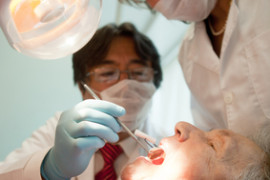A new game-changing study published in the Journal of the American Heart Association showed that when we address clinical views of gum disease plus bacteria and microbial approach, we can slow down the progression of blockage in the carotid artery. This is big news for both the medical and dental communities, so let’s break it down:
First of all, what is CIMT?
CIMT stands for Carotid Intima‐Media Thickness, or the thickness of the inner layers of the arterial wall. The thickness of the carotid artery is important because thickening of the carotid artery is almost 100% associated with thickening of the arteries around the heart. This means we can easily look at your neck with an ultrasound and get a pretty accurate glimpse of your heart health. To put it simply, you’re on the fast track to a heart attack if you have an elevated CIMT. With that in mind, do you see the significance of this latest study? If addressing periodontal disease slows the progression of thickening of the carotid artery, and the carotid artery almost always mirrors the thickness of the arteries around the heart, research is yet again showing that oral care is good for the heart! You will never hear me say that oral care is the only cure-all for any inflammatory disease. But it may be the most important factor. Research shows us that most deadly chronic diseases are caused by modifiable factors—and in my eyes oral health is the easiest yet most often overlooked.
Old vs. New Dentistry
When I talk about old-style versus new-style dentistry, old style is visual; what we can see: probe, pocketing, bleeding gums, tartar, calculus. But we can’t see what we can’t see. The new approach is to look at not only the clinical visual presentation, but also to approach it from a microbial perspective. Periodontal disease is a chronic, gram-negative microbial infection. It’s quite literally a wound. When you address it by reducing oral biofilm, you have success periodontally and systemically. And the only way to have success is to treat early, treat effectively, and address the microbial burden.
Breaking down barriers
In the past, there was a barrier between physicians’ care and dentists’ care. The tides are changing, and each study like this that comes out is another blow to the wall between the healthcare professions. This is not about dentists trying to become physicians; it’s not about physicians giving dental care. This is just another in a long line of studies that demonstrates how the healthcare communities can have a great impact working together. It’s about communicating and coordinating goals to address inflammatory disease. We have an unprecedented opportunity to rally behind this cause to improve a lot of lives and reduce a lot of costs.
The great thing about all of this new research coming out is that it can be incorporated into any healthcare model, whether you’re a physician, dentist, or speaker/advocate. All of us can unite to spread awareness and really improve a lot of lives. These studies aren’t just about some “pie in the sky” future proving what will be done someday. This is happening right NOW.




